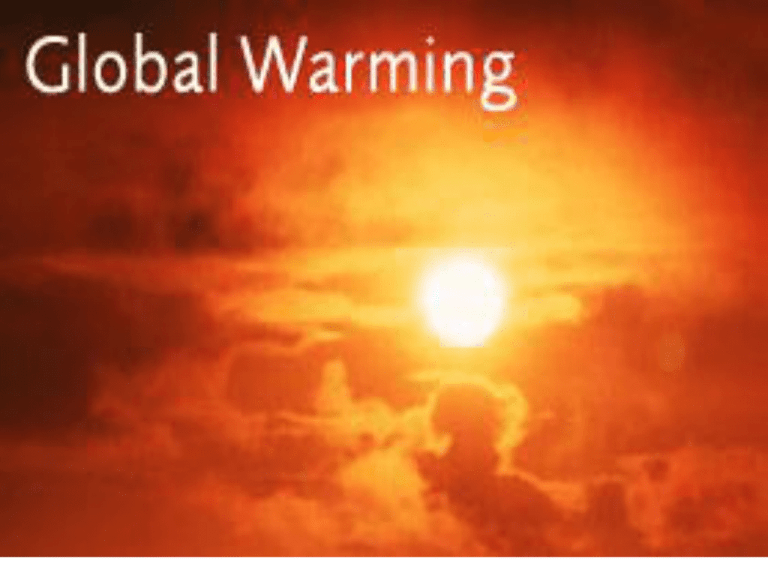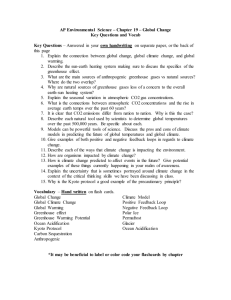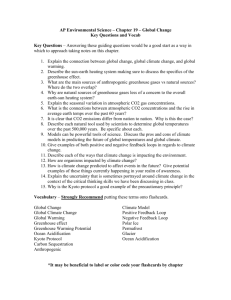Document 14521870
advertisement

Global Warming What is it? What is Global Warming and What is the Greenhouse Effect? • Global Warming: Global warming refers to an average increase in the Earth's temperature, which in turn causes changes in the global climate. • The Greenhouse Effect: The warming of the atmosphere by the trapping of long wave radiation being radiated to space. The gases most responsible for this effect are water vapor and carbon dioxide. • But how does the Greenhouse Effect work? A Greenhouse Effect we can all relate to! The Greenhouse Effect • The Greenhouse Effect is unquestionably real and helps to regulate the temperature of our planet. It is essential for life on Earth and is one of Earth’s natural processes. • Without a natural greenhouse effect, the temperature of the Earth would be about (-18°C) instead of its present (14°C). • The concern is not with the fact that we have a greenhouse effect, but whether human activities are leading to an enhancement of the greenhouse effect • The Concern is real and the reality is that we are in deed enhancing the greenhouse effect!!! What are the Greenhouse Gases? • Many chemical compounds found in the Earth’s atmosphere act as “greenhouse gases.” These gases allow sunlight to enter the atmosphere freely. When sunlight strikes the Earth’s surface, some of it is reflected back towards space as infrared radiation (heat). Greenhouse gases absorb this infrared radiation and trap the heat in the atmosphere. • There are many gases which exist that either directly or indirectly act as greenhouse gases. Furthermore, some gases have more dramatic effects then others. Direct Greenhouse Gases Carbon Dioxide (CO2) - Carbon dioxide is without doubt the most well known greenhouse gas. It is also the greenhouse gas man contributes to most, primarily through burning fossil fuels. Since the industrial revolution concentrations of carbon dioxide in our atmosphere have increased at an even faster rate. • So how quickly are CO2 levels rising? Main Sources of CO2 1) Stationary energy consumption (eg. power stations) - coal fuelled power generation is the worst culprit for carbon dioxide emissions -Oil and gas fuelled energy generation tends to have a lower carbon dioxide emission but due to its high use, still accounts for about half of all human caused C02 emissions. - Even those energy generation strategies without apparent use of fossil fuels generally have some associated carbon dioxide emissions. Nuclear power, for instance, relies on large amounts of electricity for fuel processing and so indirectly results in carbon dioxide emissions. Main Sources of CO2 • 2) Transportation - Globally, transport related emissions of carbon dioxide are growing rapidly. The use of petroleum as a fossil fuel for transportation dominates carbon dioxide emissions from this source. - Despite the rising costs of fuel, fuel consumption levels continue to rise. The large consumption of gas through vehicles is impacted by many factors including the following; number of vehicles on the road, types of vehicles on the road (SUV’s, smart cars, transport trucks, etc), traffic conditions, urban sprawl (distance vehicles have to travel), and maintenance of vehicles (emissions tests, oil changes). - Energy use (stationary and transportation) are the main contributors to human made CO2. Direct Greenhouse Gases Methane (CH4) • • Sources: Natural - Wetlands, Termites, the Oceans Human Made - Ruminants (livestock), Waste Treatment, Rice Agriculture, Biomass Burning Direct Greenhouse Gases Nitrous Oxide (N2O) • Sources: Natural – The Oceans, the Atmosphere, Soils Human Made – Agricultural soils, Biomass burning, Livestock, Transportation Other Direct Greenhouse Gases • • • • • Tropospheric Ozone Water Vapor (in the stratosphere) CFC’s Chlorofluorocarbons HFC’s Hydrofluorocarbons Perfluorocarbons (PFCs) and sulphur hexafluoride (SF6) with atmospheric lifetimes of more than 1000 years. Indirect Greenhouse Gases • Nitrogen oxides (NOx) act as indirect greenhouse gases by producing the tropospheric greenhouse gas 'ozone' during their breakdown in the atmosphere. • Carbon monoxide (CO) - can lead to the formation of the tropospheric greenhouse gas 'ozone'. • Hydrogen (H2) - hydrogen increases the lifetime of some direct greenhouse gases, such as methane. • Volatile organic compounds or VOCs - encompasses many compounds including hydrocarbons, alcohols, and organic acids. Man-made emissions tend to be concentrated in highly populated areas such as cities What Might Happen? Cause and Effects 1) Global temperatures will rise!!! • Is the climate warming? YES! • Global surface temperatures have increased about 0.6°C since the late-19th century, and about 0.2 to 0.3°C over the past 25 years • How about each year, how hot is it really getting? Lets take a look at the average temperatures since the 1880’s and see the projections of where we are going. • Then we can look at the top 20 hottest ever recorded yearly temperatures! The 20 Hottest Years on Record 2) The Ice is Melting! • The Ocean waters are already rising due to increases in the earths temperature (warm water expands!) • Icebergs don't raise sea levels when they melt because they're floating, which means they have displaced all the water they're ever going to. • Ice on land, like Greenland's, is a different matter. Pour that into oceans and you deluge shorelines. • Just an FYI, the melting permafrost will release vast amounts of trapped carbon (CO2/CH4) into the air. • Another FYI, glaciers, which have a very high albedo, are diminishing, so more heat is being absorbed by the earth which will result in higher temperatures. Ice is thinning Antarctica, home to these Adélie penguins, is heating up. The annual melt season has increased up to three weeks in 20 years. At sea, in the Canadian high Arctic, a polar bear negotiates what was once solid ice. Bears are drowning as warmer waters widen the distance from floe to floe Upsala Glacier, Argentina, which was once one of the grandest glaciers to ever exist, continues to shrink on a yearly basis 3) Oceans Currents • Warmer oceans can be mean colder continents within a hotter globe. • Larger amounts of fresh water are being added to our oceans. • If oceans becomes diluted by freshwater, the salt concentration drops, and the water gets lighter, idling on top and stalling some currents. • Ocean currents running between warm and cold regions serve as natural thermoregulators, distributing heat from the equator toward the poles. 4) Drought • An increase in the occurrence of drought – Areas that lack precipitation over a long period of time. • As fast as global warming is transforming the oceans and the ice caps, it's having an even more immediate effect on land. • People, animals and plants living in dry, mountainous regions like the western U.S. make it through summer thanks to snowpack that collects on peaks all winter and slowly melts off in warm months. Lately the early arrival of spring and the unusually blistering summers have caused the snowpack to melt too early, so that by the time it's needed, it's largely gone. • Global warming is tipping other regions of the world into drought in different ways. Higher temperatures bake moisture out of soil faster, causing dry regions that live at the margins to cross the line into fullblown crisis. 5) Flora and Fauna • Hot, dry land can be murder on flora and fauna, and both are taking a bad hit. Wildfires in such regions as Indonesia, the western U.S. and even inland Alaska have been increasing as timberlands and forest floors grow more parched. The blazes create a feedback loop of their own, pouring more carbon into the atmosphere and reducing the number of trees, which inhale CO2 and release oxygen. • With habitats crashing, animals that live there are succumbing too. Environmental groups can tick off scores of species that have been determined to be at risk as a result of global warming. • In Alaska, salmon populations are at risk as melting permafrost pours mud into rivers, burying the gravel the fish need for spawning. Small animals such as bushy-tailed wood rats, alpine chipmunks and piñon mice are being chased upslope by rising temperatures, following the path of the fleeing trees. Pacific salmon populations fell sharply in 1997 and 1998, when local ocean temperatures rose 6 degrees F. Costa Rica announced that two-thirds of 110 species of colorful harlequin frogs have vanished in the past 30 years The Quiver tree (S. Africa), is starting to die off as it struggles to survive in arid conditions that are now worsening 6) Extreme Weather • As the world warms, some extreme climate events, like the frequency of heat waves and very heavy precipitation, are expected to increase. • Blizzards and snow storms may actually increase in intensity and frequency in some colder locations • As climate change gathers pace, devastation caused by extreme weather is becoming more common. • Many extreme weather events require energy, often in the form of heat. As temperatures increase, extreme weather events will tend to increase in severity. • The number of hurricanes that occurred in 2004 was the thirdhighest number in the 1950-2004 window. • The 2005 Atlantic hurricane season was the most active Atlantic hurricane season in recorded history Bushfires are becoming more and more common due to intense heat and long periods without precipitation. Bushfire numbers are especially on the rises in countries like the US and Australia Tornadoes are increasing in number and in severity, perhaps an effect of global warming Hurricanes are increasing in numbers and in severity, Hurricanes require warm ocean temperatures in order to form. What’s being Done? • In 1992 nations from around the world met at the United Nations Earth Summit in Rio and agreed to voluntarily reduce greenhouse gas emissions to 1990 levels by the year 2000. The Rio Treaty was not legally binding and, because reducing emissions would likely cause great economic damage, many nations will not meet the goal. • Nation representatives met again in December of 1997 at a conference in Kyoto to sign a revised agreement. • Since then, a number of negotiations on Kyoto have taken place in Buenos Aires, Argentina, Bonn, Germany, the Hague, Netherlands, and in Kyoto again. The Kyoto Protocol • What is it? The objective is the "stabilization of greenhouse gas concentrations in the atmosphere at a level that would prevent dangerous anthropogenic interference with the climate system • The Kyoto Protocol is an agreement under which industrialized countries will reduce their collective emissions of greenhouse gases by 5.2% compared to the year 1990 (this target represents a 29% cut). • The Protocol also reaffirms the principle that developed countries have to pay, and supply technology to, other countries for climaterelated studies and projects. Countries Positions Canada • • • • On December 17, 2002, Canada ratified the treaty. Numerous polls have shown support for the Kyoto protocol around 70% After January 2006, the Liberal Party government was replaced by a Conservative Party minority government under Stephen Harper, who previously has expressed opposition to Kyoto. On April 25, 2006, it was announced that Canada would have no chance of meeting its targets under Kyoto, and would instead look to participate in U.S. sponsored Asia Pacific Partnership on Clean Development and Climate. • On May 2, 2006, it was reported that environmental funding designed to meet the Kyoto standards has been cut, while the Harper administration develops a new plan to take its place. United States • The United States of America (USA), although a signatory to the protocol, has neither ratified nor withdrawn from the protocol. • The current President, George W. Bush, has indicated that he does not intend to submit the treaty for ratification, not because he does not support the general idea, but because of the strain he believes the treaty would put on the economy • The position Bush has taken on climate change has shifted with a gradual increasing acceptance that global warming is a problem, and that it is partly caused by human activity. The United States has signed the Asia Pacific Partnership on Clean Development and Climate, a pact that allows those countries to set their goals for reducing greenhouse gas emissions individually, but with no enforcement mechanism. Australia • Australia has refused to sign the Agreement due to issues with the protocol. The Australian Prime Minister, John Howard, has argued that the protocol would cost Australians jobs, and that Australia is already doing enough to cut emissions. The Federal Opposition, the Australian Labor Party, is in full support of the protocol and it is currently a heavily debated issue within the political establishment. The opposition claims signing the protocol is a "risk free" prospect as they claim Australia would already be meeting the obligations the protocol would impose. As of 2005, Australia was the world's largest emitter per capita of greenhouse gases. • The Australian government, along with the United States, agreed to sign the Asia Pacific Partnership on Clean Development and Climate at the ASEAN regional forum on 28 July 2005. India • India signed and ratified the Protocol in August, 2002. Since India is exempted from the framework of the treaty, it is expected to gain from the protocol in terms of transfer of technology and related foreign investments. At the G-8 meeting in June 2005, Indian Prime Minister Manmohan Singh pointed out that the per-capita emission rates of the developing countries are a tiny fraction of those in the developed world. • Following the principle of common but differentiated responsibility, India maintains that the major responsibility of curbing emission rests with the developed countries, which have accumulated emissions over a long period of time. The Kyoto Protocol • The agreement came into force on February 16, 2005 following ratification by Russia (55 percent )on November 18, 2004 • As of April 2006, a total of 163 countries have ratified the agreement • Notable exceptions include the United States and Australia. • Other countries, like India and China, which have ratified the protocol, are not required to reduce carbon emissions under the present agreement. What Can We Do? • Knowledge is Power! Just being informed on the issue of global warming is one huge step forward. Sharing our knowledge with others and showing them that we care is the best thing we can do. • The next best thing is to be a leader and to live a life that reflects our beliefs. We can only provide others with the information we know but we can not force our beliefs on to them. • As such, we must make the changes to our own lives that will better benefit the environment and global warming as a whole. Believe it or not, one person can make a difference! So what will you do ? Top 10 Things You can do to stop Global Warming • 10.Plant a couple of additional trees around your home.CO2 reduction = 20 lbs/year • 9.Use a push mower to cut your lawn instead of a power mower.CO2 reduction = 80 lbs/year • 8.Replace your home’s refrigerator with a high-efficiency model.CO2 reduction = 220 lbs/year • 7.Buy food or other products with reusable or recyclable packaging instead of non-recyclable packaging.CO2 reduction=230 lbs/year • 6.Replace your washing machine with a low-energy, lowwater-use machine.CO2 reduction = 440 lbs/year Top 10 Things You can do to stop Global Warming • 5. Install a solar thermal system to help provide your hot water.CO2 reduction = 720 lbs/year • 4. Recycle all of your homes waste: newsprint, cardboard, glass and metal.CO2 reduction = 850 lbs/year • 3.Leave your car at home two days a week (walk, bike or take public transportation to work instead).CO2 reduction = 1,590 lbs/year • 2. Insulate your home, tune up your furnace, and install energy efficient shower heads.CO2 reductions = 2,480 lbs/year • 1.Purchase a fuel efficient car (rated up to 32 mpg or more) to replace your most frequently used automobile.







